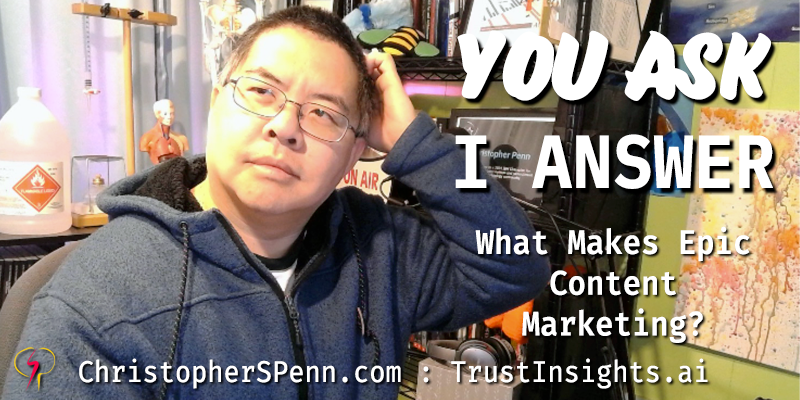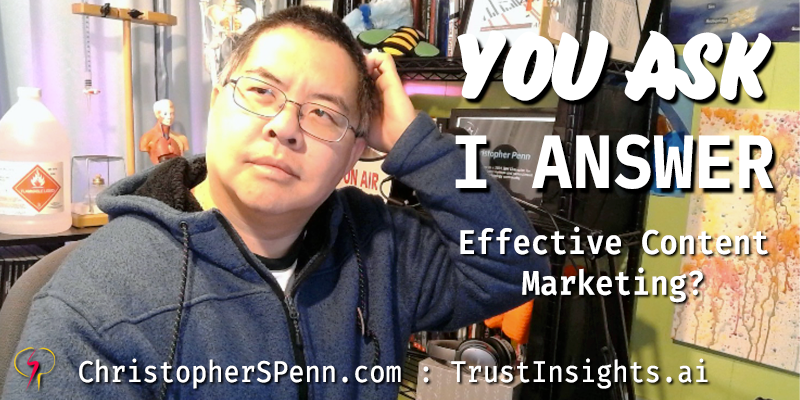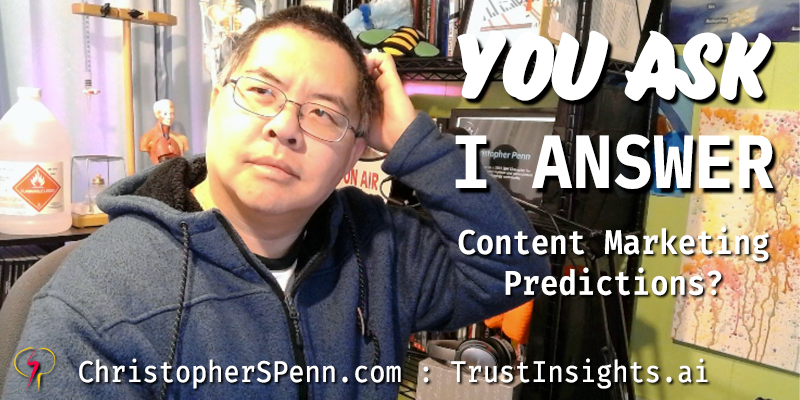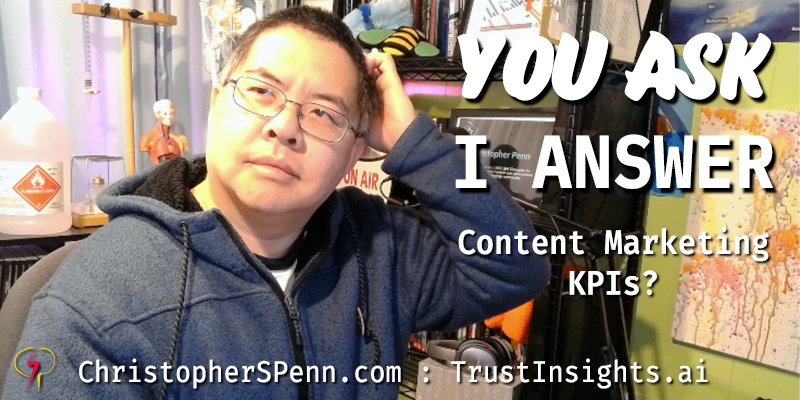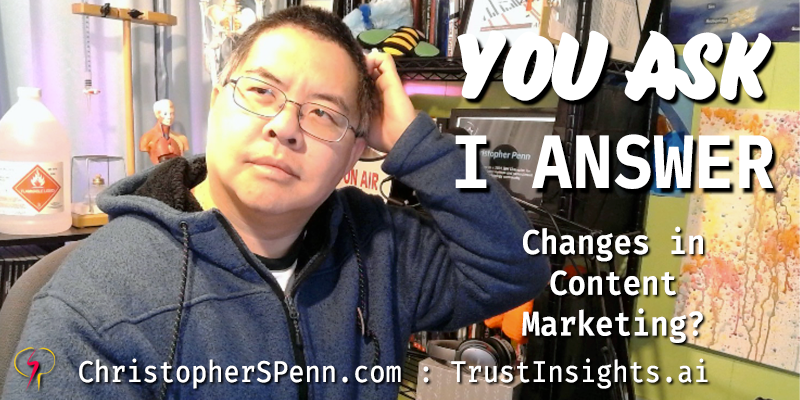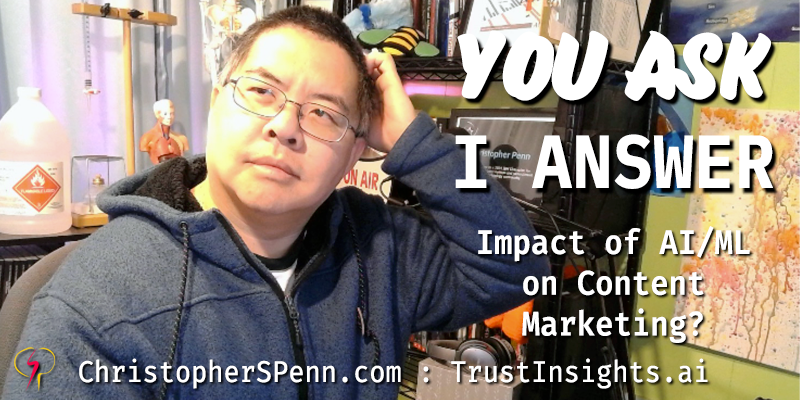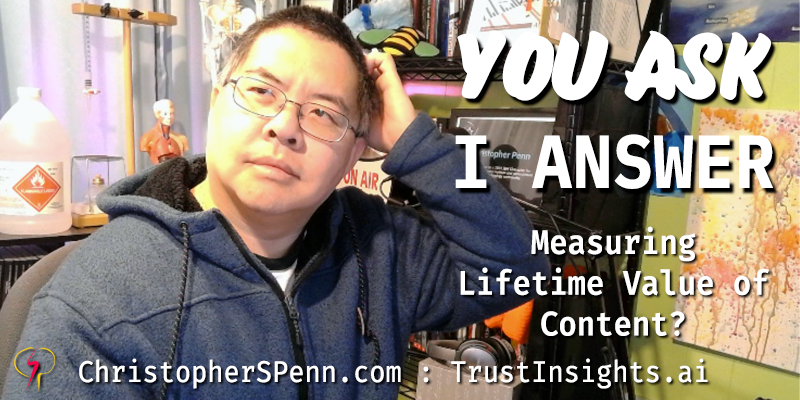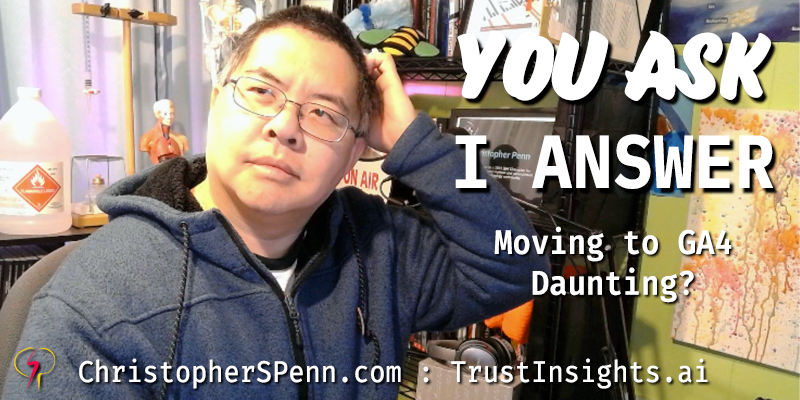Almost Timely News, 8 May 2022: AI and Inequality, Epic Content Marketing (5/8) :: View in Browser
Take my new course on Google Search Console and how to use it for your marketing »
Happy Mother’s Day to all who fulfill that role in life.
Watch This Newsletter On YouTube
Click here for the video version of this newsletter on YouTube »
Click here for an MP3 audio only version »
What’s On My Mind: AI and Inequality
This week, I was talking with the Trust Insights team about our marketing strategy, looking at our April results. I said something kind of funny: let’s just jettison our SEO focus. Now, on the surface, that seems kind of silly, doesn’t it? Ignoring a channel you don’t pay for seems like a poor idea. But let me dig into the reasoning behind this.
When I started doing what we now call SEO, back in the 90s, there were no artificial intelligence algorithms at work. There were no deep neural networks, no fancy recommendation engines, and during that time, small companies had a real shot at being found as often and as prominently as big companies.
When deep neural networks really started becoming the backbone of search engines (around 2015), the game changed. What happened? Big web properties became bigger, ranked better, accrued more traffic and attention. Small web properties got squeezed out for top volume searches.
Why? It has nothing to do with SEO. It’s not a global conspiracy to let big corporations win. It’s much simpler than that.
Inequality is built into AI with a bias towards letting bigger entities win.
Here’s the simple explanation. To build an AI model – which is fancy for machine-written software – you need data. You need a LOT of data. There’s a reason Google gives away so many services like Google Photos, Google Voice, Google Search, etc. Their AI models need material to train on, so the more they collect – and the more we volunteer – the better the models perform.
Well, when you’re ranking content, who can create better content at scale? Brands that have the budget and resources to do so. It’s that simple. A company that has 5 employees on its content marketing team will inherently create less content than a company that has 500 employees on its content marketing team.
And when you’re building an AI to return search results and you crawl the web, weeding out the obvious crap, you’re left with what? A pile of good content where by simple mathematics, more of that content was created by larger organizations that had the resources to build it.
Add in features like Google’s reliance on “Expertise/Authority/Trustworthiness” (as documented in their Search Quality Ratings Guidelines), and you have an even bigger bias towards larger brands with larger budgets. Why? Who do you trust? You trust entities you’ve had positive experiences with, and you trust brands that deliver consistent experiences – as well as investing heavily in brandbuilding.
Thus, by definition again, a brand that can put a million Euros into brand building is going to have more recognition, authority, and trust than a brand that doesn’t invest in brand building.
Here’s a simple thought exercise:
- Name a coffee shop brand.
- Name a fast food brand.
- Name a store brand you shop in.
- Name a mobile phone manufacturer.
Did any of the choices you mentally summoned just now spend nothing and no effort on brand building? Probably not. Chances are you thought of brands that invest incredible amounts of money and effort in brand building.
Because of its nature of needing a lot of data to build models, AI will always favor the larger data sources. And larger data sources will correlate strongly with larger brands and larger budgets, because that’s who can afford to create the data that AI needs to train on.
So what are you supposed to do if you don’t have big budgets? How do you survive in a world where the deck is firmly stacked against you by big budget competitors and artificial intelligence algorithms working against you?
Wind back the clock 50 years. How did small businesses stay alive in a world where all media was controlled by large corporations and they had absolutely no voice? Three simple things worked for challenger brands.
- Create a product/service that is substantially better. This is table minimum. If your product or service isn’t noticeably better to your customers, your marketing efforts will be in vain. Get this right first.
- Create a community. Whether it’s something modern like a Discord server or something old school like a mailing list, have a way for people to interact with you – especially your most loyal, ardent fans. This is your insurance policy against AI – when customers spread news of your brand by word of mouth through communications channels that aren’t mediated by algorithms – like chat groups, SMS, direct messages, emails, etc. – AI can’t interfere with the spread of your brand.
- Create a memorable brand. At the end of the day, search engines can’t interfere with customers if customers don’t have to search for you. If you are top of mind in your customers’ heads, they will turn to you directly instead of needing an intermediary. There’s no way for an AI algorithm to intercept you typing in my company’s URL directly in your browser.
So how will I be putting this to work? Have I given up on SEO? Sort of. As we discussed in our team meeting this week, we’re pivoting towards a strategy of SEO as a nice-to-have, rather than a core marketing channel. We’ll still create great content, but our intent and our focus is to create content that real people – you – actually ask for, because we know at least one person will read it!
We’ve been saying since 2006 on Marketing Over Coffee that the most sound SEO strategy in the world is to operate as though there were no search engines at all, that Google didn’t exist. That strategy is more true now than ever. How would you market if search didn’t exist at all? How would you stay in front of customers, remind them that you exist in ways that still provide them value? Whatever that strategy is, do it.
Share With a Friend or Colleague
If you enjoy this newsletter and want to share it with a friend/colleague, please do. Send this URL to your friend/colleague:
https://www.christopherspenn.com/newsletter
ICYMI: In Case You Missed it
Besides the new Search Console course I’m relentlessly promoting (sorry not sorry), I would recommend reading the pieces on epic content marketing. They were fun!
- You Ask, I Answer: How to Make Epic Content Marketing?
- You Ask, I Answer: What Makes Epic Content Marketing?
- You Ask, I Answer: Predictions for the Future of Content Marketing?
- {PODCAST} In-Ear Insights: Will AI Wipe Out Data Science Jobs?
- So What? Will AI take my job?
- Almost Timely News, 1 May 2022: Minimums, Changes in Content Marketing
Skill Up With Classes
These are just a few of the classes I have available over at the Trust Insights website that you can take.
Premium
Free
- How to Prove Social Media ROI (new!)
- Fundamentals of Marketing Analytics
- How to Think About Google Analytics 4
- Proving Social Media ROI
- Paradise by the Analytics Dashboard Light: How to Create Impactful Dashboards and Reports
- How to Deliver More Value as an Agency
Get Back to Work!
Folks who post jobs in the free Analytics for Marketers Slack community may have those jobs shared here, too. If you’re looking for work, check out these five most recent open positions, and check out the Slack group for the comprehensive list.
- Senior Growth Marketing Manager at Forma.ai
- Head of CRO at Tripscout
- Senior Adtech Manager at Mytheresa
- Content Manager at Rock Content
- Senior Account Manager at WebMechanix
- Content Marketing Project Manager at Masthead Media
Advertisement: Google Search Console for Marketers
Of the many tools in the Google Marketing Platform, none is more overlooked than Google Search Console. Marketers assume it’s just for SEO, but the information contained within benefits search, social media, public relations, advertising, and so much more. In my new Google Search Console for Marketers course, you’ll learn what Google Search Console is, why it matters to all marketers, and then dig deep into each of the features of the platform.
When you’re done, you’ll have working knowledge of the entire platform and what it can do – and you’ll be ready to start making the most of this valuable marketing tool.
Click/tap here to register – and use discount code ALMOSTTIMELY for $50 off the registration »
Thank You Notes
These are the places you’ve had or mentioned me – on your podcast, on your blog, in your newsletter. Thank you!
- Getting Smarter in 2022 – Elja Daae
- Hold ’em or Fold ’em? Using AI to Evaluate Your Marketing Effectiveness – Secret Sushi
- Interview with Christopher Penn – Onalytica
- Everything is Measurable in Marketing – MarTech.org
- Why You Need Data In Your PR Strategy – Veracity
- Making Sense of Data Quality Amongst Current Seasonality & Uncertainty
What I’m Reading: Your Stuff
Let’s look at the most interesting content from around the web on topics you care about, some of which you might have even written.
Social Media Marketing
- 7 AI-Powered Content Creation Tools for Social Media Managers
- The TikTok Algorithm Explained via Sprout Social
- Utilizing Social Media Marketing To Increase Profits Oh My Global Tips
Media and Content
- Content Writing: How To Write and Order Different Types of Content
- Update or delete? Cleaning up old content on your site Yoast
- Influencer Marketing Experts Pick Their Favorite Tools To Manage Their Programs
SEO, Google, and Paid Media
- App Store SEO: The Inbound Marketer’s Guide to Mobile via Moz
- Generating Query Answers via SEO by the Sea
- Minification and SEO: The Complete Guide via BrightEdge
Advertisement: Ukraine Humanitarian Fund
If you’d like to support humanitarian efforts in Ukraine, the National Bank of Ukraine has set up a fund specifically for relief efforts. You can donate using a Visa/Mastercard or Google Pay.
Donate today to the Ukraine Humanitarian Relief Fund »
Tools, Machine Learning, and AI
- 5 employment AI regulations takeaways for technical decision-makers via VentureBeat
- Google AI Blog: Auto-generated Summaries in Google Docs
- Machine Learning Is Not Like Your Brain Part One: Neurons Are Slow, Slow, Slow via KDnuggets
Analytics, Stats, and Data Science
- AI in Analytics: Top Use Cases and Tools
- Enrich Server-side Data With Cloud Firestore via Simo Ahava’s blog
- Handling Missing Values with Random Forest via Analytics Vidhya
All Things IBM
Advertisement: Inbox Insights Newsletter
If you enjoy this newsletter, you’ll also enjoy Inbox Insights, the Trust Insights newsletter. Every Wednesday, get new perspectives, fresh data you won’t find anywhere else, plus a roundup of content we’ve made for the week, like our podcast and our livestream.
Events I’ll Be At
Here’s where I’m speaking and attending. Say hi if you’re at an event also:
- Spark.me Social Media, June 2022, Montenegro
- MarTech Conference, June 2022, virtual
- MAICON, August 2022, Cleveland, OH – use code PENN150 for $150 off any conference ticket
- MarketingProfs B2B Forum, October 2022, Boston
Events marked with a physical location may become virtual if conditions and safety warrant it.
If you’re an event organizer, let me help your event shine. Visit my speaking page for more details.
Can’t be at an event? Stop by my private Slack group instead, Analytics for Marketers.
How to Stay in Touch
Let’s make sure we’re connected in the places it suits you best. Here’s where you can find different content:
- My blog – daily videos, blog posts, and podcast episodes
- My YouTube channel – daily videos, conference talks, and all things video
- My company, Trust Insights – marketing analytics help
- My podcast, Marketing over Coffee – weekly episodes of what’s worth noting in marketing
- My second podcast, In-Ear Insights – the Trust Insights weekly podcast focused on data and analytics
- On Twitter – multiple daily updates of marketing news
- On LinkedIn – daily videos and news
- On Instagram – personal photos and travels
- My free Slack discussion forum, Analytics for Marketers – open conversations about marketing and analytics
Required Disclosures
Events with links have purchased sponsorships in this newsletter and as a result, I receive direct financial compensation for promoting them.
Advertisements in this newsletter have paid to be promoted, and as a result, I receive direct financial compensation for promoting them.
My company, Trust Insights, maintains business partnerships with companies including, but not limited to, IBM, Cisco Systems, Amazon, Talkwalker, MarketingProfs, MarketMuse, Agorapulse, Hubspot, Informa, Demandbase, The Marketing AI Institute, and others. While links shared from partners are not explicit endorsements, nor do they directly financially benefit Trust Insights, a commercial relationship exists for which Trust Insights may receive indirect financial benefit, and thus I may receive indirect financial benefit from them as well.
Thank You!
Thanks for subscribing and reading this far. I appreciate it. As always, thank you for your support, your attention, and your kindness.
See you next week,
Christopher S. Penn



